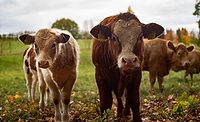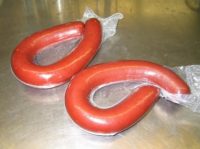For decades, researchers have been developing edible films for food packaging and preservation. But the material dissolves when exposed to water, and that’s a problem for packaged food with high water content and wet surfaces.
Now, food scientists at Oregon State University have combined two naturally occurring fibers to develop a water-resistant and antimicrobial edible film that has the potential to extend the shelf life of food with wet surfaces, such as meat, cheese and cut fruit and vegetables.
The film is similar in texture and appearance to plastic wrap but it is edible and made out of a combination of two naturally occurring substances. One is chitosan, a fiber derived from crustacean shells, and the other is cellulose nanofiber, a tiny material originally extracted from wood pulp.
“We put two unique materials together to enhance the functionality of food packaging and solve very challenging problems facing the food industry,” said Yanyun Zhao, a professor of food science at Oregon State University who led the film’s development.
Chitosan, a key ingredient in crab shells and shrimp shells, acts as an antimicrobial and an antioxidant. In tests with fresh beef patties in her lab, Zhao and her team combined the strengths of both fibers. Wrapped around the patties, the film inhibited the growth of Escherichia coli and Listeria, and it prevented the surface moisture transfer between the layered patties.
“We improved water resistance, antimicrobial functionality and mechanical properties, so the film has broad applications as stand-alone films for packaging food with high water content or as coatings for food with wet surfaces,” Zhao said.
The film could replace non-biodegradable waxed papers or other synthetic polymers that are currently used in meat packaging, Zhao said.
Further study is needed to validate its application in other food products, she said. While cellulose nanofiber and chitosan are prepared from natural sources, for food usage and human consumption they need approval to obtain a “Generally Recognized as Safe” label from the U.S. Food and Drug Administration.
Zhao has a long track record for developing edible films and coatings that prolong the shelf life of foods.
In 2004, she and her colleague patented a chitosan-lysozyme composite film/coating technology for food applications. In 2009, she developed a coating for fish fillets that incorporates chitosan and fish oil. In 2013, she used pomace, the typically discarded pulp from crushed wine grapes, to make colorful, edible coatings and films that can be stretched over fruits, vegetables and other food products. They contain antioxidants and control the growth of some bacteria.
Chris Branam is a public issues communication specialist at Oregon State University.




